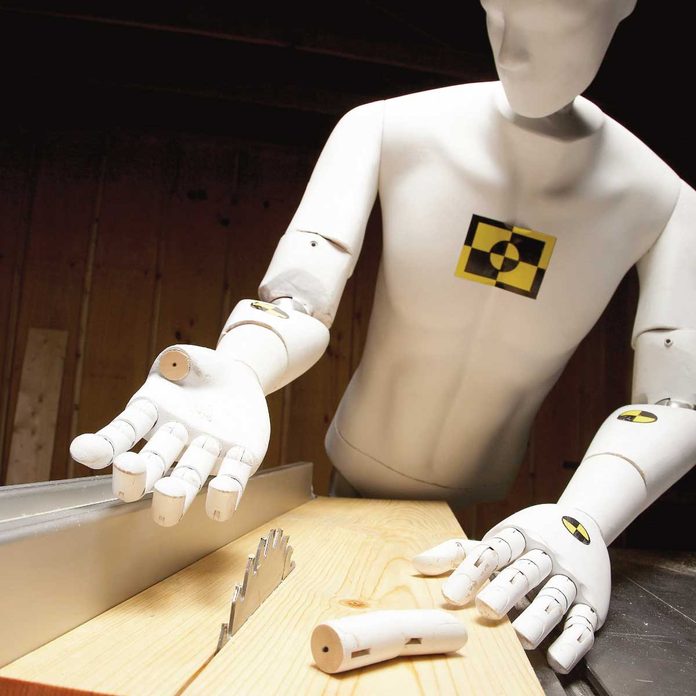
What’s the best way to demonstrate really dangerous tool practices without taking the risk of hurting someone? With a crash test dummy, of course! It’s just not easy to explain stupid techniques using words alone. That’s where our dummy, Nigel, comes in!
Every year, emergency rooms report 120,000 visits for injuries caused by four tools: table saws, circular saws, nail guns and utility knives. Add to this the 200,000 ER visits for eye injuries—a large percentage of which occur during work around the house—and it’s easy to see how we came up with this list of the most dangerous don’ts.
Our dummy, Nigel, is making some common mistakes that can result in severe injuries. But these are only a few examples of things not to do. Don’t you be a dummy! When you start on your next project, keep these don’ts in mind so you don’t become the next statistic.
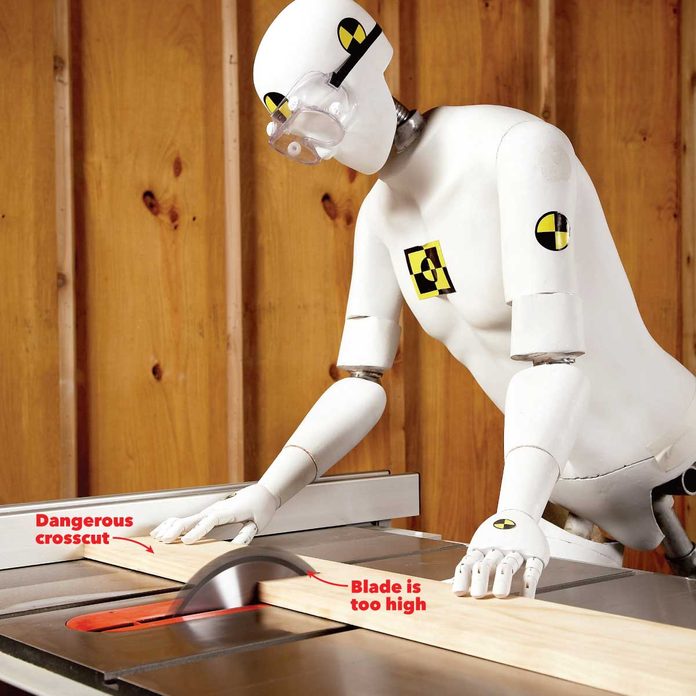
Don’t use the table saw fence for crosscuts
Nigel the dummy is demonstrating one of the most dangerous table saw practices: cutting a board to length using the fence as a guide. There’s a good chance the board will get pinched between the blade and the fence and get thrown back into his body with lots of force. That nasty incident is called “kickback.” Broken thumbs, cracked ribs, ruptured spleens and punctured eyes are only a few of the resultant injuries you can suffer. About 35,000 people end up in the emergency room every year with table saw injuries, with 10 percent of them hospitalized. Industry experts estimate that about half of table saw injuries are caused either directly or indirectly by kickback.
In addition to avoiding the dangerous technique Nigel is using to crosscut a board, here are a few other ways to prevent kickback injuries:
- Don’t cut anything that’s longer than it is wide with the shorter side against the fence. If you want to crosscut with a table saw, use the miter gauge or a crosscutting sled.
- Avoid ripping wet, bowed or twisted lumber.
- Position your body to the right or left of the miter saw slots, not directly behind the blade.
- Don’t let bystanders walk behind you when you’re operating the saw.
CAUTION: Don’t use the fence as a guide for crosscutting. Instead, use the miter gauge or build a crosscutting sled.
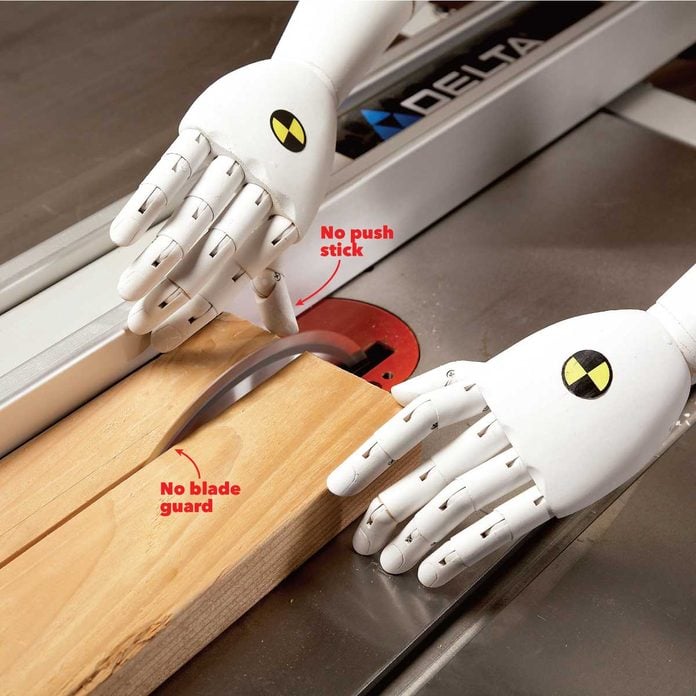
Don’t remove that blade guard!
Every table saw sold includes a blade guard, which has a splitter attached. The guard covers the blade, preventing you from accidentally touching it, and the splitter keeps wood from pinching on the blade and kicking back. Don’t take them off! Sure, the guard may be a nuisance at times, but it’s better to be inconvenienced than to lose one or more fingers. Of the 35,000 emergency room visits we talked about earlier, 83 percent involve contact with the blade.
If you’re buying a table saw, consider spending extra for the SawStop brand. It’s the only saw on the market that stops the blade when skin touches it. If your blade guard is missing, contact the manufacturer for a replacement. An add-on guard like the HTC Brett-Guard ($200 to $375) is a good option if your original guard is missing or doesn’t work well. If $200 sounds like too much money, ask yourself what a finger is worth.
Even with a blade guard installed, you should keep your fingers away from the blade. Always use a push stick for rips less than 4 in. wide. If you’re using your thumb to push the piece and the piece kicks back, you risk torn ligaments, tendons and broken bones. Push the cut piece past the blade, turn off the saw and wait for the blade to stop before retrieving the ripped piece. Don’t reach near a spinning blade to remove a cutoff.
CAUTION: Even a dummy should have enough common sense to avoid this technique. Nigel’s finger is so close to the blade that a split second of inattention or a kickback could send him to the crash-test dummy hospital.
Push sticks are incredibly important with a table saw. Check out this magnetic version from POWERTEC.
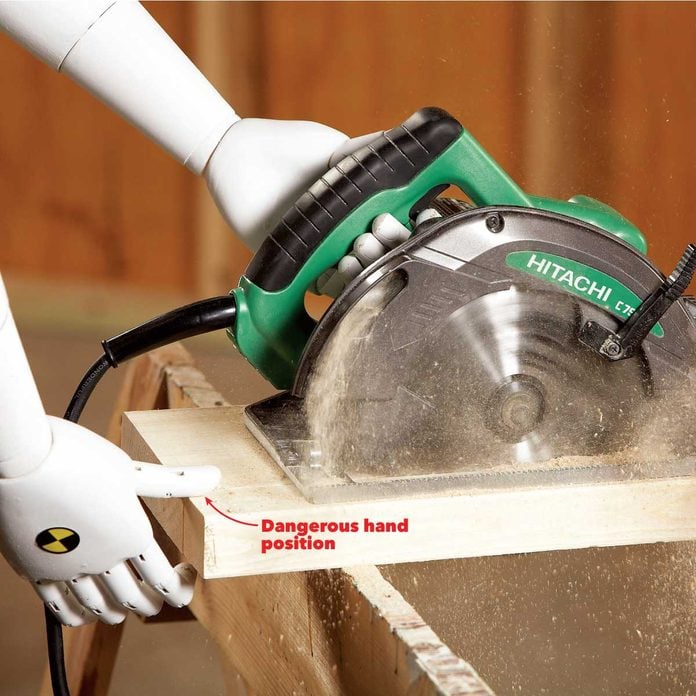
Don’t put your hand directly behind a circular saw
There are an estimated 14,000 visits to the emergency room every year as a result of circular saw injuries. Many of these injuries result in lost or severely damaged fingers. When you’re using a circular saw, remember that if the blade binds, the saw can shoot backward a lot faster than you can move your hand out of the way. Anything in the blade’s path, including fingers, hands, legs or feet, is in danger of getting cut. Avoid the risk by clamping your work and keeping both hands on the saw whenever possible. Also keep your body to the side of the saw rather than directly behind it.
CAUTION: Don’t hold a board like this. Use a temporary nail or clamp instead. Nigel risks losing a finger or two if the saw binds.
Learn more circular saw tips and techniques here.
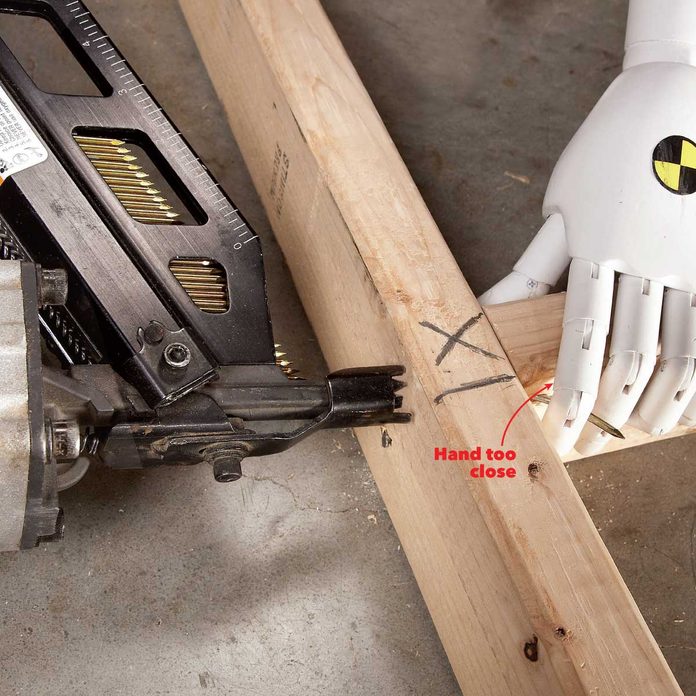
Don’t put your hands near a nail gun
Even if you’re a nail gun expert, nails don’t always go straight. Wood grain or knots can deflect the nail and cause it to shoot out the side of the board. If you’re driving the nail at an angle to toenail a board, there’s a good chance the nail can glance off and go shooting into space. If you must hold a board with your free hand, keep it well away from the nail gun muzzle. If you’re reaching over a board to hold it down, move your hand out of the nail’s path. Also avoid shooting into large knots that can deflect the nail. And, of course, always wear eye protection when you’re using a nail gun.
CAUTION: Don’t hold a board close to the nail gun tip. Move your hand as far back as possible to avoid getting a nail through your finger.
Framing is a tough job. Find some handy framing tricks here.
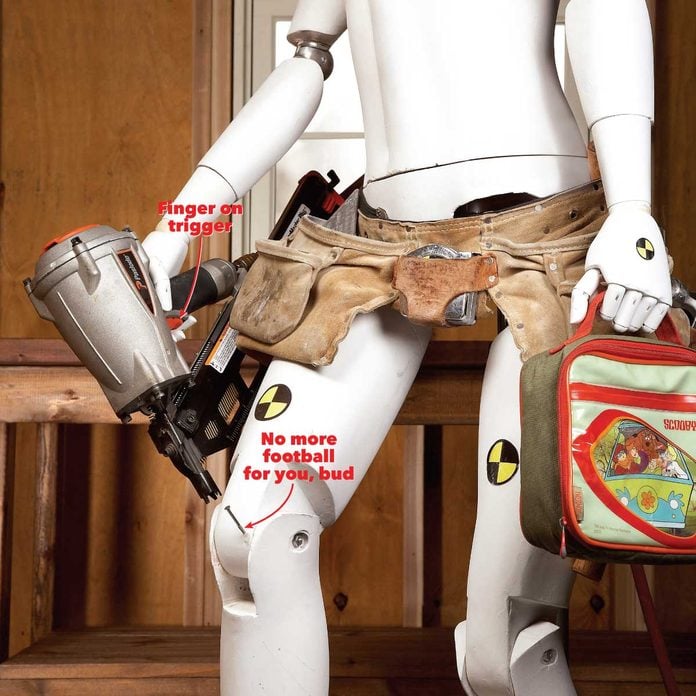
Don’t be sloppy with nail guns
You’ve all seen the news stories. X-rays of big nails embedded in someone’s head, lodged in a spine or stuck in a foot. Ask any carpenter and you’re sure to hear a story about a nail that went through a finger or hand. A tool that’s powerful enough to shoot a 3-in.-long nail into wood can easily penetrate skin and bone. Depending on the type, some nail guns can be set to “bump-trip.” In this mode, the operator can simply hold down the trigger and bump the nail gun nose against the surface to shoot a nail. This is great for speeding up jobs like nailing down plywood sheathing, but it creates a risk if you hold the trigger while carrying the nail gun. Bump your leg and you’ll be heading to the emergency room. In incidents where accidental contact caused an injury, more than 80 percent of the time the operator had a finger on the trigger.
There are two ways to avoid this. First, get out your owner’s manual and see if you can set your nail gun to sequential mode. This requires you to push down the muzzle and then pull the trigger for each nail. Second, keep your hand off the trigger when you’re carrying a nail gun, or better yet, unplug the hose. Then there’s no chance of accidental firing.
CAUTION: Nigel should have disconnected the hose and kept his finger off the trigger while he went for his lunch break. You can reduce the chance of a nail gun injury by taking these two steps.
See the safety mistakes Hollywood has made over the years. Some are pretty hilarious.
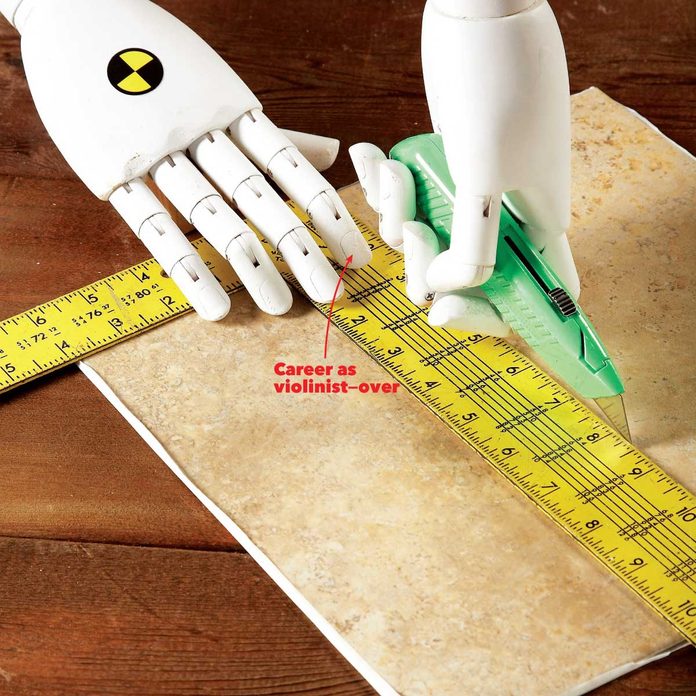
Don’t get careless with a knife
Power tools are one thing, but did you know that utility knives are one of the most dangerous tools, accounting for a whopping 60,000 estimated emergency room visits a year? One slip is all it takes to put a deep cut in any body part that’s in the way. And while most cuts are superficial and may only require a few stitches, permanent tendon and nerve damage is common.
The best way to avoid an injury is to clamp materials whenever possible to avoid having to hand-hold them. If you do have to hold something while you’re cutting, imagine a line at right angles to the cutting line and keep your hand behind it (on the dull side of the blade).
CAUTION: Nigel’s finger is in the danger zone. If the knife slips, he’ll end up with a nasty cut or worse. Keep your hands out of the blade’s path.
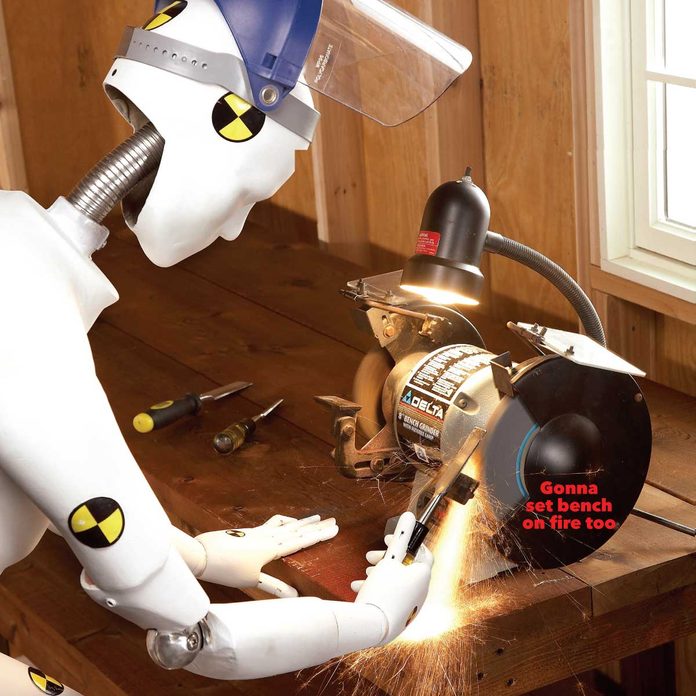
Don’t risk your eyes
It’s hard to think of a good reason not to wear safety glasses, goggles or a face shield when you’re working around the house. It’s obvious that Nigel should be wearing his face shield. Of the more than 200,000 emergency room visits a year for eye injuries, at least 10,000 of them involve grinders. Browsing accident reports on the Internet will convince you of the risk. Wood chips, metal shards, bits of tile, household chemicals, paint, solvents and sticks are some of the things that injure eyes. The good news is that it’s easy to protect your vision. Just choose the right eye protection for the task at hand. For general work around the house, wear ANSI-approved safety glasses or goggles. Look on the frame for the “Z87+” marking, which indicates that the glasses are rated for high impact. Wear a face shield for grinding operations. Buy several pairs of safety glasses and keep them in convenient locations so you’ll always have them on hand. Plus: Learn more bench grinder basics you need to know here.
RED ALERT: Nigel is a dummy! He’s got eye protection readily available and isn’t using it. Keep eye protection handy and don’t forget to wear it.
Every product is independently selected by our editors. If you buy something through our links, we may earn an affiliate commission.